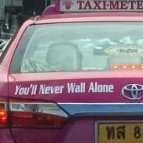Chiang Rai Smog Reaches Critical Level
-
Recently Browsing 0 members
- No registered users viewing this page.
-
Topics
-
-
Popular Contributors
-
-
Latest posts...
-
209
While Trump fails, Carney outsmarts him once again
So you must pay double? A fat tariff! i use words you can understand. Body shaming? Now you are using Woke words! Don't let anyone body shame you,you keep waddling at your own pace. Nice weather over there in the US? Have a great day! -
15
The One Trump Flaw Most Americans Can’t Tolerate - Incompetence
What's even worse (and I've pointed this out before) - anyone who thinks these are 47's ideas isn't thinking this through. He's just the distraction clown doing his idiotic dances while truly evil men like Stephen Miller and Russell Vought are the real architects of this dictatorship. Hell, they aren't even hiding it any more. Project 2025 is in full blown implementation. The spineless Democrats are clutching pearls, writing "strongly worded emails," or taking childish pictures of themselves holding softball bats, thinking this will ensure the public they're doing something. As much as I hate just about everything the above poster spews, he's right on that point. Dems will not win the the mids or 2028. -
179
What happened to Rock n Roll
If this is rock’n’roll, I want my old job back -
17
USA Women Shouldn't Be Allowed to Vote? Hegseth's Video Sparks Fury!
No, I'm very much against that. Why remove the vote for blacks? They are not the ones causing the dangerous decline of the Democrat Party, congestion on the roads, or causing employment issues, the general decline of society by refusing to have children, causing divorce and other societal ills, that's women. Blacks are just a minority, why should they not have the vote? Makes no sense. Many black men are homeowners too, so they should definitely have the vote. Black men who do not own property could, just as whites who do not own property, have a somewhat reduced voting right once those who own property have their voting rights amplified. Sure. But a wholesale removal of the vote for blacks would be excessive and extreme. After all some of our best comedians, athletes and musicians are blacks. -
23
why are all airlines thick as.....
They both have lawyers working for them, who they have to pay anyhow. It will cost the customer a lot more money to start this. -
7
Car insurance cancelled with no warning.
Do they have the right to cancel your policy if a payment instalment is missed for some reason? Easy to happen if deducted from a credit card and the one on file has expired and you don't realise. Seems like you are saying that the June payment was not deducted, for whatever reason, and then when next one was due they cancelled. IE they didn't just cancel without anything else happening, a payment was missed first. Of course they should then contact you first to say "this payment failed; your policy is at risk if you don't pay up now" etc. And just curious - you bought a pick up 12 years ago and its still on finance! That's an impressively long payment plan.
-
-
Popular in The Pub


.thumb.jpg.7316bde19cef79dbf73e679639122dfb.jpg)








Recommended Posts
Create an account or sign in to comment
You need to be a member in order to leave a comment
Create an account
Sign up for a new account in our community. It's easy!
Register a new accountSign in
Already have an account? Sign in here.
Sign In Now